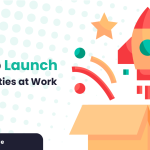
Our team loves to share articles around topics that resonate with us, and help to further advance the MixR mission and values. A couple months ago, we posted our first ever “Article Spotlight” highlighting a framework for leaders to transform their workplaces into high-trust environments. This week, we’re highlighting a piece by Katica Roy, David G. Smith and W. Brad Johnson in Harvard Business Review entitled “Gender Equity Is Not Zero Sum.”
The article makes it clear that achieving gender equity in the workplace is not an ‘us versus them’ issue - a fact that resonates strongly with our team at MixR. We must all work together to achieve this balance, and in doing so, we will all reap the benefits. In fact, organizations that focus on inclusive behaviors achieve better business outcomes. So what’s stopping us?
The issue of gender equity is often framed as a women’s issue. Because of the zero-sum bias that exists among employees, many are led to believe that participating in this cause will come at their expense. For reference, zero-sum bias is a cognitive bias that causes individuals to mistakenly believe that one group’s gains are another’s losses - in other words, the belief that mutually beneficial outcomes cannot be achieved. This Harvard Business Review piece provides an actionable list of concrete steps organizations can take to eliminate this bias and make progress towards gender equity.
Before diving deeper, we pulled out a few key figures that emphasize the urgent need to address this issue:
- From 2019 to 2020 we moved backwards, adding 55 years to the estimated time needed to close the gender gap in economic equality. Without significant change, we could need another 257 years to close this gap.
- The problem has worsened during the pandemic - prominently affecting Black women, who have seen 1.4 million jobs disappear since February 2020.
- Research from Pipeline shows that across 4,161 companies in 29 countries, for every 10% increase in gender equity, businesses see a 1% to 2% increase in revenue.
The solutions provided include quantifying gender equity in terms of economic gain, tying D&I metrics to performance reviews and the implementation of various training & intervention methods for leaders. However, the ones that really speak to us are those centered around establishing cross-gender professional relationships and shared-identity. At MixR, we believe in the power of positive social interactions and community in the workplace. Communities@work foster psychological safety, belonging and trust - key ingredients for boosting employee engagement and well-being. Allowing employees to build meaningful relationships with one another can serve to break down barriers, and encourage personal growth and empathy. Fostering a culture of openness, where diverse perspectives are celebrated, encourages the type of collaboration that boosts long-term business performance. All in all, advancing gender equity in the workplace will require tackling systemic cultural behaviors that have been present for decades. Every part of the organization must contribute to the movement. It will not be easy, and it will certainly not happen overnight, but there are concrete steps organizations can take today for a better tomorrow. We hope you enjoyed this edition of our blog series. Stay tuned for more weekly insights from across our team! In the meantime, if you’re an organization looking to advance your D&I initiatives through community-building, MixR may be right for you. Feel free to connect with us to learn more.
Share this article
Share with your contacts
or
Share via your social networks
LinkedIn
Facebook







